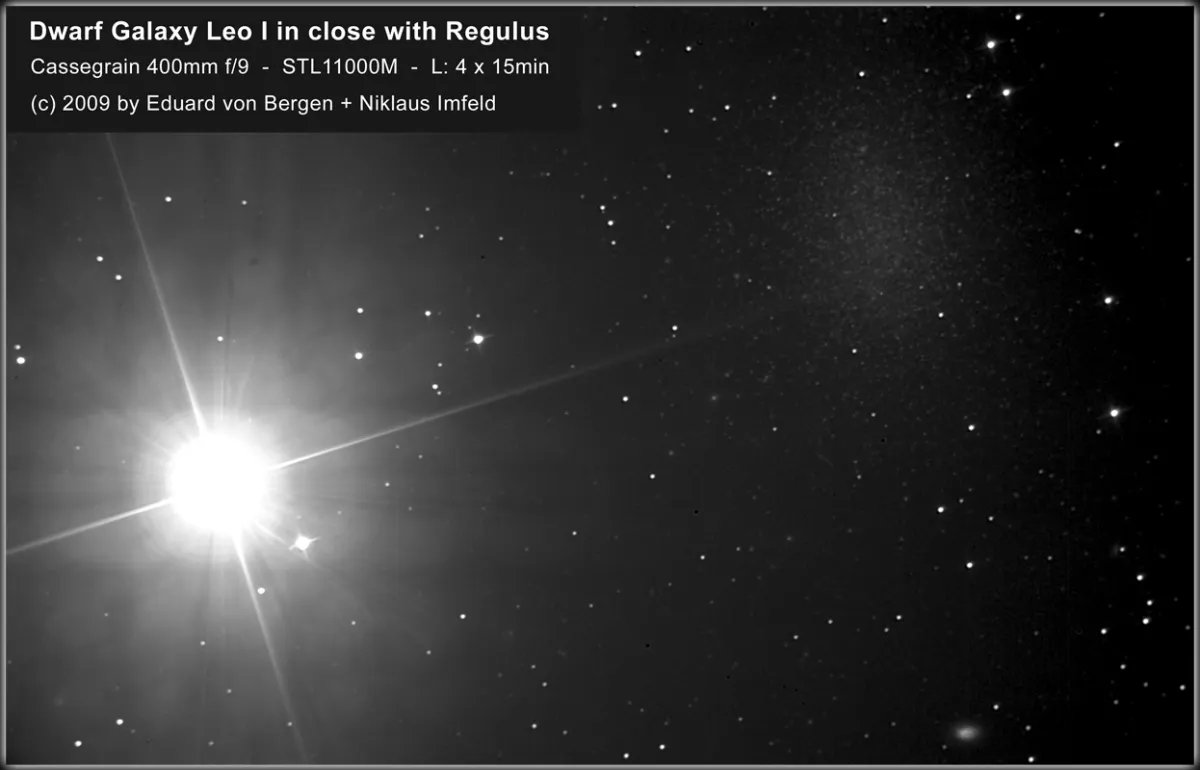Leo I Dwarf Galaxy


History
Due to its proximity of only 12 arc minutes to the 1.4 mag bright star Regulus (α Leonis), Leo I (UGC 5470) remained undiscovered for a long time. It was discovered in 1950 along with Leo II by R.G. Harrington and A.G. Wilson in the Palomar Observatory Sky Survey (POSS) photographic plates. [217]
Physical Properties
Leo I (also Leo 1) is a dwarf elliptical galaxy. It belongs to the Local Group and is a distant companion of our Milky Way. According to measurements published on Simbad, this dwarf galaxy is 0.198 Mpc to 0.26 Mpc (645'800 to 848'000 light-years) away and is receding at a speed of 251 km/s to 290 km/s. The brightness in the V-band is 10.0 mag. [145]
From observations with the Hubble Space Telescope, Gallart et al 1999 conclude that 70-80 percent of star formation took place between seven and one billion years ago. There is little to no evidence for the presence of stars older than 10 billion years. About a billion years ago, star formation abruptly dropped to negligible levels. However, very little star formation appeared to have occurred up to 300 million years ago. [264]
| Designations | PGC 29488: Leo I, UGC 5470, MCG 2-26-27, DDO 74, CGCG 64-73, ANON 1005+12 |
| Right Ascension (J2000.0) | 10h 08m 27.4s |
| Declination (J2000.0) | +12° 18' 27" |
| Morphological Type | E |
| Dimensions | 9.9' x 7.5' |
| Visual Magnitude | 11.1 mag |
| Radial Velocity (HRV) | 168 km/s |
| Position Angle | 80° |
Galaxy IC 591

The small galaxy IC 591 is much further away. It is of the morphological type SBc. The distance is 41 Mpc (133 million light years) and it is receding at a speed of about 2800 km/s. [145] The small galaxy was discovered on 8 February 1878 by the American astronomer David Peck Todd with a 26 inch reflector. This apparently escaped John LE Dreyer, because in his «Index Catalogue» published in 1895 he names Stephane Javelle as the discoverer who observed IC 591 on 31 March 1892. [277, 314]
| Designation | IC 591 |
| Type | Gx (S?) |
| Right Ascension (J2000.0) | 10h 07m 27.6s |
| Declination (J2000.0) | +12° 16' 27" |
| Diameter | 1 × 0.7 arcmin |
| Photographic (blue) magnitude | 14.1 mag |
| Visual magnitude | 13.2 mag |
| Surface brightness | 12.7 mag·arcmin-2 |
| Position Angle | 170° |
| Redshift (z) | 0.009470 |
| Distance derived from z | 40.00 Mpc |
| Metric Distance | 40.500 Mpc |
| Dreyer Description | pF, S, R |
| Identification, Remarks | UGC 5458; MCG 2-26-25; CGCG 64-69; ARAK 231; Todd 22 |
Finder Chart
The dwarf galaxy Leo I is located in the constellation Leo, just 12 arc minutes north of the mag 1.4 star Regulus. It is like the galaxy NGC 404 or the planetary nebula Abell 12 a good test object for the transparency of the sky and the contrast performance of the telescope. On 19 February it is in opposition to the Sun and culminates at local midnight. The best observation time is October to July.
Visual Observation
762 mm aperture: If Regulus is held outside the 0.52° field of view, a small elliptical-shaped cotton swab is visible north of this at 192x magnification (Tele Vue Ethos 13mm). — 30" SlipStream-Dobson f/3.3, Hasliberg, 17. 2. 2021, Eduard von Bergen
